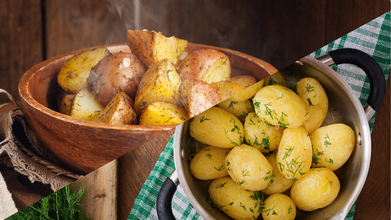- Health Conditions A-Z
- Health & Wellness
- Nutrition
- Fitness
- Health News
- Ayurveda
- Videos
- Medicine A-Z
- Parenting
- Web Stories
How Much Protein Is Too Much Protein?

Credits: Canva
Protein has earned a reputation as the building block of life, and for good reason. As one of the three essential macronutrients, alongside carbohydrates and fats, it plays a critical role in keeping your body functioning. From oxygen transport and immune defense to nerve signaling and tissue growth, protein is involved in nearly every system in your body.
But while it’s clear that protein is important, a question often comes up: Can you have too much of it? Let’s break down what the science says about protein requirements, and whether eating more than your daily share poses real risks.
How Much Protein Do You Really Need?
Your protein needs aren’t one-size-fits-all. They depend on several factors: your weight, age, physical activity, body composition goals, and overall health status.
The Recommended Dietary Allowance (RDA) for the average adult is 0.36 grams per pound (0.8 grams per kilogram) of body weight. This amount is generally enough to meet basic nutritional needs for most sedentary adults.
However, experts suggest that people who are physically active often need more, anywhere from 0.54 to 0.9 grams per pound (1.2–2 grams per kilogram) per day. Athletes may even require higher amounts to support muscle repair and performance.
Certain groups, such as pregnant or breastfeeding individuals, older adults, and people recovering from illness or injury, also have increased protein needs. For example, during pregnancy, the recommendation rises to about 0.5 grams per pound (1.1 grams per kilogram).
Are High-Protein Diets Harmful?
For years, concerns have circulated about the safety of high-protein diets, particularly regarding their potential impact on the kidneys, heart, and bones. But research suggests that many of these fears are unfounded — at least for healthy individuals.
Heart Health
Some worry that consuming too much protein, especially from animal sources, might raise the risk of heart disease. However, large-scale studies have not found a consistent link. One study involving over 12,000 adults found no association between animal or plant protein intake and heart disease risk. Similarly, reviews in 2020 and 2023 concluded that high protein intake was not connected to increased risks of stroke, cardiovascular death, or other heart-related conditions.
Bone Health
Earlier research hinted that high-protein diets might weaken bones by increasing calcium loss. Yet more recent evidence shows the opposite. A 2019 review of 13 studies found that higher protein intake — above the current RDA, was linked to stronger bones and a reduced risk of hip fractures. Since protein makes up over one-third of bone mass, adequate intake, alongside calcium and vitamin D, supports skeletal health.
If you’re thinking about ramping up your protein intake, the key is balance and individualization. While high-protein diets appear safe for most healthy people, your exact needs depend on your lifestyle, age, and health conditions.
Working with a registered dietitian or qualified healthcare provider can help you find the right amount for your body while ensuring your diet stays balanced with other nutrients. After all, protein is powerful, but it works best as part of a well-rounded eating plan.
Celebrity Nutritionist Shares 5 Signs Of Poor Diet

Credits: Canva
If you think “healthy eating” is just about protein shakes, cutting carbs, and stocking your fridge with probiotic shots, celebrity nutritionist Rujuta Diwekar wants to have a word with you. Known for guiding Bollywood’s biggest names, including Kareena Kapoor, Rujuta is famous for her practical, grandma-approved advice. In her August 11 Instagram post, she listed five signs your diet is not only unsustainable but also joyless. And her antidote is simple: good old home-cooked food.
1. Protein Overload
While protein is important, your diet should not look like a bodybuilding competition menu. You might do more harm than good. Rujuta warns that loading up on a single nutrient creates imbalance both on your plate and in your gut. If dal, sabzi, roti, and a bit of rice have been replaced with chicken breasts and protein bars, you are not nourishing yourself; you are overdoing it.
2. No Spice, No Fun
Somewhere along the way, you ditched your daily pickle, chutney, or masala because someone on the internet said, “Seasonings cause water retention.” Now, your evenings are spent rummaging through cupboards looking for anything salty, spicy, or sweet to kill the craving. Rujuta’s point is that flavour is not the enemy. A little tadka in your dal or a sprinkle of chaat masala on your salad can actually make your meals more satisfying and keep late-night snack attacks at bay.
3. Portion Panic
You start cutting back on roti. Then you take only half a spoon of rice. Next thing you know, you are eying your own fruit bowl suspiciously. This “portion paranoia” often does the opposite of what you intended: it strips meals of comfort and turns eating into a stress sport. Rujuta reminds us that eating enough is essential, not indulgent. Confidence does not come from calorie counting; it comes from nourishing your body so it works with you, not against you.
4. Festivals Feel Like Cheating
If modak during Ganpati, sheer korma on Eid, or Christmas cake feels like a guilty transgression, your diet is robbing you of more than calories; it is stealing your joy. Food is culture, connection, and celebration. The minute your “diet plan” turns family gatherings into anxiety traps, it is no longer healthy. Rujuta says that food is culture, community, and cuisine. It is a wholesome way to live.
5. Gut Health Overload
Once upon a time, a happy stomach meant you ate on time and enjoyed your meals. Now, you have got a probiotic drink, a prebiotic pill, and some digestive tonic, yet your gut feels perpetually off.Ironically, over-focusing on “gut health” can stress your digestive system further. Sometimes, what your stomach really needs is not a lab-formulated elixir but a home-cooked khichdi and curd.
Why Home-Cooked Food Wins Every Time
Rujuta’s core philosophy is deceptively simple: eat what you can make at home, using local, seasonal ingredients, without obsessing over macros and metrics.Why? Because home-cooked food naturally ticks all the boxes; it is balanced, economical, and emotionally grounding. It does not just help you lose weight; it helps you stop making weight loss the centre of your life.
A plate of fresh roti, ghee-topped dal, sabzi, and a little pickle is not just dinner; it is tradition, nutrition, and comfort, all in one. Plus, it is far cheaper than imported almond flour or cold-pressed mushroom juice.
Rujuta’s five red flags are a reminder that eating well should add to your life, not shrink it down to a list of forbidden foods.
What Happens To Your Skin, Joints And Gut After 30 Days Of Taking Collagen?

Credits: Canva
Collagen has long been a nutritional superhero, cloaked in homemade bowls of chicken soup and Jell-O's wiggly texture. Now it's in the spotlight—mixed into morning coffee, blended into smoothies, or found in capsules because it's said to promote young-looking skin, supple joints, and even a healthier digestive tract. But if you take collagen daily for a month, what can you reasonably expect?
Collagen is the most widely found protein in the human body, and it forms the structural skeleton of your skin, cartilage, bones, and connective tissue. It consists largely of three amino acids—proline, glycine, and hydroxyproline—and functions like the skeletons that keep you assembled together.
Although your body naturally makes collagen, production decreases with age, beginning as early as your mid-20s. The consequences? Wrinkles, loss of skin elasticity, joint stiffness, and bone loss. Collagen supplements try to fill in the void, delivering your body with peptides that can potentially trigger it to make its own collagen.
The supplements themselves are generally derived from bovine (cow), porcine (pig), or marine (fish) sources. After processing, they become taste-free powder, capsule, or liquid that's convenient to incorporate into your diet.
Skin
One of the largest selling points of collagen supplementation is smoother, more youthful skin. The research supports the notion—albeit with qualifiers. A 2021 International Journal of Dermatology review discovered that consuming collagen for 90 days increased hydration and elasticity, with some subjects reporting fewer wrinkles than those who didn't supplement.
Collagen peptides also seem to set off the skin's fibroblasts (cells that make collagen) to increase production. After a while, that could mean plumper, tougher skin. Just remember that everyone is different, and the results come slowly you won't wake up with a "filtered" complexion after four weeks.
Also Read: How To Tell Your Skin Barrier Is Damaged? Step-By-Step Guide To Rebuilding Your Skin’s Defenses
Joints
Collagen is not all about looks—collagen is also very important for the health of joints. Type II collagen, specifically, is the main building block of cartilage, the padding tissue that lets joints glide smoothly.
There are some studies that recommend a daily consumption of collagen to decrease pain and function in individuals with joint problems. In Amino Acids, a review in 2021 indicated that 5 to 15 grams per day of collagen peptides improved participants' comfort and mobility. Collagen may also aid in quicker recovery when coupled with resistance exercise in people who are active or have been injured.
Bones
Bone density tends to decrease naturally with age, particularly in women after menopause. Collagen composes approximately one-third of bone weight, contributing to the bones' elasticity and strength. There has been some evidence—like a 2021 study published in the Journal of Bone Metabolism—that collagen supplements could increase bone mineral density and stability in postmenopausal women.
Although you will not experience this advantage in 30 days, sustained use might help make a difference in bone density, particularly when combined with calcium, vitamin D, and weight-bearing exercise.
Gut Health
Collagen has amino acids such as glycine and glutamine that can potentially keep the gut lining healthy. This is significant because an intact gut barrier is inflammation-reducing and helps with digestion. Although human studies are ongoing and preliminary, anecdotal evidence is that daily collagen consumption can alleviate bloating or discomfort in some individuals.
Hair and Wound Healing: Secondary Benefits
Your hair consists mainly of keratin, and that depends on the amino acids in collagen. Supplementation may be aided by some research, such as a 2022 review in the International Journal of Molecular Sciences, to support hair thickness and hair growth. Likewise, collagen's function in skin structure would make it accelerate wound healing—a benefit backed by evidence in burn victims.
Why Collagen Is Not A Magic Portion?
Even with the encouraging results, collagen is not a panacea. "Most physicians aren't aggressive about prescribing it, because the data just isn't there," says Dr. Peden, an orthopedic expert. The studies are encouraging but still in the making, and outcomes vary with diet, lifestyle, and genetics.
That is the reason why professionals suggest looking at collagen as part of a holistic health strategy that incorporates nutrient-dense foods, proper exercise, sun protection, and adequate sleep.
How to Choose and Use Collagen?
Since supplements aren’t regulated by the FDA, quality matters. Look for products that are independently verified, free of unnecessary fillers or sugars, and sourced from reputable companies. The most common types to look for are:
Type I and III – Best for skin, hair, and overall healthy aging.
Type II – Most linked with joint health.
Powders are the most convenient, but capsules are a good alternative if you don't want to mix powders in water. Although there is no traditional daily recommended dose, the majority of studies utilize 5 to 15 grams per day.
How To Consume Collagen Naturally?
Even when supplementing, lifestyle choices count:
- Consume protein foods such as chicken skin, bone broth, and whole fish to offer building blocks for collagen.
- Take adequate vitamin C from fruits and vegetables such as bell peppers, strawberries, and citrus to support collagen production.
- Exercise regularly—both resistance and aerobic training can encourage collagen synthesis.
- Shield your skin from UV, don't smoke, and restrict alcohol.
What Happens When You Take Collagen For 30 Days?
If you begin daily collagen, you can expect subtle improvements in your skin—slightly improved hydration or texture at the end of the first month. Joint pain may start to subside, particularly when combined with strength training or physical therapy.
More pronounced effects, particularly for skin elasticity, bone health, or hair growth, usually take 8 to 12 weeks or longer of regular use. Collagen is a long game, not a Band-Aid.
Collagen has its hype for a reason—it is involved in skin elasticity, joint ease, and overall structural well-being. Not everybody will notice earth-shattering shifts in 30 days, but regular usage, particularly in conjunction with healthy behaviors, can complement your body's natural repair and maintenance capabilities.
Disclaimer: This information is for educational purposes only and is not a professional medical consultation, diagnosis, or treatment. Always consult a qualified healthcare provider before taking any supplement.
Boiled vs Cooled Potatoes: How Resistant Starch Affects Your Glycemic Index

Credits: Canva
Potatoes are the quiet chameleons of the culinary world. They slip onto our plates in every possible form—creamy mashed with gravy, golden fries next to a burger, baked with a dollop of sour cream, or tossed into a chilled potato salad. They’re inexpensive, easy to grow, and endlessly adaptable, which is why they’ve long been a staple in homes across the United States and beyond but not all potatoes are created equal when it comes to health—especially when it comes to how they affect your blood sugar. The difference can come down to how they’re cooked, cooled, and the amount of resistant starch they hold.
There was a time when fresh potatoes were served at dinner almost daily in the average American household. Over the past few decades, though, their popularity has declined while processed potato products—French fries, chips, frozen wedges—have taken center stage.
Health experts often point out that despite technically being a vegetable, potatoes shouldn’t always be counted in the same category as leafy greens or cruciferous vegetables when building a balanced plate. The reasoning is simple: their nutrient profile is different, with less fiber and fewer micronutrients per calorie than vegetables like spinach or broccoli.
A medium potato with its skin intact provides about 2–3 grams of fiber and around 600 mg of potassium. But here’s the catch—boiling and other wet cooking methods cause some potassium to leach out. That’s why preparation matters.
Potatoes are rich in carbohydrates, mostly in the form of starch. The main type, amylopectin, breaks down quickly into glucose, causing a spike in blood sugar—a hallmark of foods with a high glycemic index. That’s why mashed potatoes or fries can cause a sharper blood sugar rise than, say, lentils or quinoa.
There’s also amylose, a type of starch that digests more slowly. The starches that resist digestion—appropriately named resistant starch—act more like dietary fiber, passing through the small intestine undigested and reaching the large intestine where they feed beneficial gut bacteria. Here’s where the cooking method comes in:
Baking and microwaving potatoes generally preserve more resistant starch than boiling.
Boiling, then cooling potatoes, significantly increases their resistant starch content.
New or young potatoes, harvested before full maturity, naturally have more amylose than older, fully mature potatoes.
Why Cooling Changes the Effect Potatoes Have On Our Health?
When a potato is boiled, its starch granules gelatinize, making them more digestible. But if you allow the potato to cool completely—like you would for a potato salad—some of those gelatinized starches reorganize into a crystalline form that resists digestion. This process, known as retrogradation, increases the amount of resistant starch.
This means that the same potato can have a lower glycemic index when eaten cold compared to hot. Lower glycemic index foods cause a slower, steadier rise in blood sugar, which may help reduce spikes that contribute to insulin resistance over time.
Benefits of Resistant Starch Beyond Blood Sugar
Resistant starch doesn’t just help flatten your post-meal blood sugar curve—it has a ripple effect across several aspects of health:
Gut health – Acts as a prebiotic, feeding beneficial bacteria in the colon.
Short-chain fatty acids – Fermentation of resistant starch produces compounds like butyrate, which support colon health and may protect against digestive disorders.
Inflammation – Potentially reduces gut inflammation by improving barrier function.
Metabolic health – Studies suggest improved insulin sensitivity and reduced fasting blood glucose in people with type 2 diabetes and obesity.
In a review of 15 clinical trials, participants consuming around 30–40 grams of resistant starch daily had lower fasting blood sugar levels, while just 10 grams a day lowered fasting insulin levels.
Potatoes vs. Whole Grains
Potatoes are often served in the same role as bread or rice—a starchy base for a meal. But nutritionally, swapping potatoes for whole grains can be a healthier choice in many cases. Whole grains consistently show stronger links to lower risk of heart disease, type 2 diabetes, and overall mortality.
This doesn’t mean potatoes are off-limits. It simply means portion size, preparation, and what you serve them with matters. Pairing them with healthy fats like olive oil instead of butter, and alongside lean proteins and vegetables, can make a big difference in the meal’s overall health profile.
Why The Role of Serving Style Is Essential?
Potatoes are naturally fat-free until we add oils, butter, cream, or deep-fry them. That’s where the calorie count and saturated fat can skyrocket. Fries with burgers, creamy mashed potatoes with meatloaf—these combinations tend to overload on calories and unhealthy fats.
On the flip side, cold potato salad dressed with extra-virgin olive oil and vinegar, paired with leafy greens and grilled fish, can be a far healthier (and more blood sugar-friendly) way to enjoy them.
Where Else to Find Resistant Starch In Your Diet?
If you’re looking to increase your resistant starch intake, potatoes are just one option. Other sources include:
- Legumes like lentils, chickpeas, and kidney beans
- Whole grains such as barley and oats
- Firm (less ripe) bananas
- Seeds and nuts
- Cooked and cooled pasta or rice
Potatoes can absolutely have a place in a healthy diet—but how you prepare and eat them matters. Cooling boiled potatoes before eating boosts their resistant starch, which can lower their glycemic index and potentially benefit gut health and blood sugar control.
© 2024 Bennett, Coleman & Company Limited

